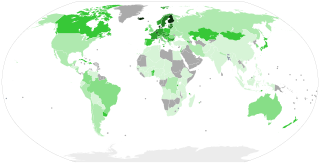| Esperanto | |||
|---|---|---|---|
| Lingvo Internacia[1] | |||
| Esperanto[2] | |||
 | |||
| Pronunciation | [espeˈranto] | ||
| Created by | L. L. Zamenhof | ||
| Date | 1887 | ||
| Setting and usage | International: most parts of the world | ||
| Users | Native: c. 1,000 (2011)[3] L2: estimated 30,000 to 2 million | ||
| Purpose | |||
Early form | |||
| Latin script (Esperanto alphabet) Esperanto Braille | |||
| Signuno | |||
| Sources | Indo-European languages of Europe,[clarification needed] vocabulary largely derived from Romance languages | ||
| Official status | |||
| Regulated by | Akademio de Esperanto | ||
| Language codes | |||
| ISO 639-1 | eo | ||
| ISO 639-2 | epo | ||
| ISO 639-3 | epo | ||
epo | |||
| Glottolog | espe1235 | ||
| Linguasphere | 51-AAB-da | ||
 Esperantujo: Number of individual UEA members per million population in 2020.
| |||
| Part of a series on |
Esperanto (/ˌɛspəˈrɑːntoʊ/, /-æntoʊ/)[7][8] is the world's most widely spoken constructed international auxiliary language. Created by L. L. Zamenhof in 1887, it is intended to be a universal second language for international communication, or "the international language" (la Lingvo Internacia). Zamenhof first described the language in Dr. Esperanto's International Language (Esperanto: Unua Libro), which he published under the pseudonym Doktoro Esperanto. Early adopters of the language liked the name Esperanto and soon used it to describe his language. The word esperanto translates into English as "one who hopes".[9]
Within the range of constructed languages, Esperanto occupies a middle ground between "naturalistic" (imitating existing natural languages) and a priori (where features are not based on existing languages). Esperanto's vocabulary, syntax and semantics derive predominantly from languages of the Indo-European group. A substantial majority of its vocabulary (approximately 80%) derives from Romance languages, but it also contains elements derived from Germanic, Greek, and Slavic languages.[10] One of the language's most notable features is its extensive system of derivation, where prefixes and suffixes may be freely combined with roots to generate words, making it possible to communicate effectively with a smaller set of words.
Esperanto is the most successful constructed international auxiliary language, and the only such language with a sizeable population of native speakers, of which there are perhaps several thousand.[3] Usage estimates are difficult, but two estimates put the number of people who know how to speak Esperanto at around 100,000.[4] Concentration of speakers is highest in Europe, East Asia, and South America. Although no country has adopted Esperanto officially, Esperantujo ("Esperanto-land") is used as a name for the collection of places where it is spoken. The language has also gained a noticeable presence on the internet, as it became increasingly accessible on platforms such as Duolingo, Wikipedia, Amikumu and Google Translate.[11][12] Esperanto speakers are often called "Esperantists" (Esperantistoj).
- ^ Zamenhof, Lazaro Ludoviko (1888). "Aldono al la Dua Libro de l' Lingvo Internacia". Dua Libro de l' Lingvo Internacia (in Esperanto) (2006 ed.). Project Gutenberg. Retrieved March 15, 2022.
Rakontinte mallonge la tutan konstruon de l' "Lingvo internacia" kaj ĝian gramatikon,[...]
- ^ "Plena Ilustrita Vortaro de Esperanto 2020".
- ^ a b Harald Haarmann, Eta leksikono pri lingvoj, 2011, archive date March 4, 2016: Esperanto. ... estas lernata ankaŭ de pluraj miloj da homoj en la mondo kiel gepatra lingvo. ("Esperanto has also been learned by several thousand people in the world as a mother tongue.")
- ^ a b 63,000 −50%/+200%: "Nova takso: 60.000 parolas Esperanton" [New estimate: 60,000 speak Esperanto] (in Esperanto). Libera Folio. February 13, 2017. Archived from the original on February 13, 2017. Retrieved February 13, 2017.
- ^ Wandel, Amri (2014). "HOW MANY PEOPLE SPEAK ESPERANTO? OR: ESPERANTO ON THE WEB". Interdisciplinary Description of Complex Systems.
A simple calculation accompanied by reasonable refinements leads to a number of approximately two million Esperanto users within the internet community alone, probably significantly more worldwide
- ^ What is UEA? Archived June 26, 2015, at the Wayback Machine, Universal Esperanto Association, 2018. Retrieved July 21, 2018.
- ^ Jones, Daniel (2003) [1917], Peter Roach; James Hartmann; Jane Setter (eds.), English Pronouncing Dictionary, Cambridge: Cambridge University Press, ISBN 3-12-539683-2
- ^ Wells, John C. (2008), Longman Pronunciation Dictionary (3rd ed.), Longman, ISBN 978-1-4058-8118-0
- ^ "Doktoro Esperanto, Ludwik Lejzer Zamenhof". Global Britannica.com. Encyclopædia Britannica Inc. Archived from the original on May 29, 2020. Retrieved December 3, 2016.
- ^ Puškar, Krunoslav (2015). Koutny, Ilona (ed.). "Common criticism of Esperanto: facts and fallacies" (PDF). Język. Komunikacja. Iinformacja (10). Poznań: 106. ISBN 978-83-63664-96-1. ISSN 1896-9585. Archived from the original (PDF) on April 18, 2016.
- ^ Cite error: The named reference
:0was invoked but never defined (see the help page). - ^ Dean, Sam (May 29, 2015). "How an artificial language from 1887 is finding new life online". The Verge. Archived from the original on December 26, 2017. Retrieved June 26, 2021.
